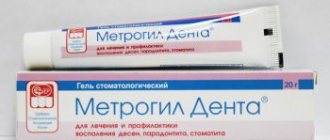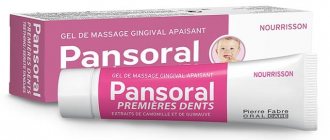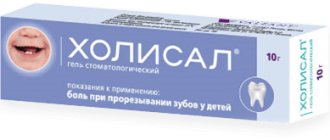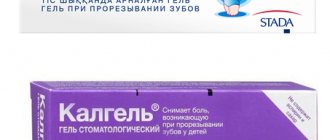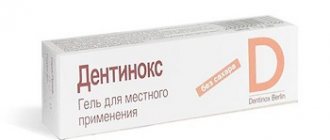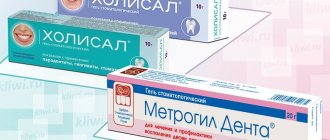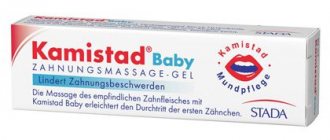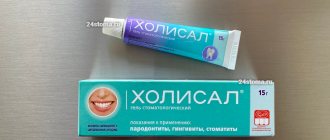Photo: spirituality.ru
Victoria Mamaeva
Chief editor of Filzor. Specialist in the field of Pharmacy
From the first days of life and throughout the years, people face oral problems. Be it the eruption of the first teeth, diseases and problems of the gums, the mucous membrane in this cavity, any illness causes discomfort, sometimes unbearable pain, and numerous undesirable consequences.
Any problem leads to the inability to eat or drink cold or slightly warm drinks. Sometimes painful wounds make it difficult to sleep peacefully. Of course, such problematic phenomena require consultation with a dentist, but in any case, you want to get rid of the pain immediately.
In such cases, the dental gel Cholisal Dental comes to the aid of both adults and children. A tube of Holisal Dental contains 15 g of medicinal mass, which miraculously relieves discomfort and, in addition, promotes the speedy recovery of damaged tissues. The product is absolutely safe and suitable for use from the first days of life. It is effective both in the case of pain during the eruption of the baby’s first teeth, and from wounds on the gums or oral mucosa in adults.
When choosing a drug, you should pay attention to the specific direction of action. In pharmacies you can find Cholisal and Cholisal Dental. Certain differences between the two drugs change the specific indications for the use of each of them.
What is the difference between Cholisal and Cholisal Dental
Many people do not pay attention to one additional word in the name of the drug. How exactly Cholisal differs from Cholisal Dental can be determined by comparing the indications for use and the composition of these two medicines. The presence of the word Dental determines the specific focus of one of the types of medications. Dental means dental, that is, for the oral cavity. However, if you compare the insert papers from the two medications, there are practically no differences from each other. It should be noted that there is also Holisal Dental for children. Although the other two types of medicine are allowed to be used by children over one year old, during the eruption of the first teeth at the age of six to eight months, it is advisable to use the children's version.
Reviews of Holisal Dental
As already mentioned in the article, there are several types of medications. There are no particular differences among them. The only difference is the price. The good old version of Cholisal costs at least 350 rubles. The tube contains 10 g of substance. In that case, the price of Holisal Dental gel for 15 grams is no more than 200 rubles. The fact is that the manufacturer has updated the product and significantly reduced the cost. The old options remained with a fixed price.
Reviews about Holisal Dental gel and its variants are only positive. Parents of teething children are especially enthusiastic. Thanks to the products, they become much calmer, sleep and eat well.
Recommendations
Reviews and instructions for the Cholisal gel are only general in nature - for various diseases there are certain features of using the product. That is why it is best to consult a dentist before use.
For example, if periodontitis or gingivitis is detected, the product is used exclusively as part of a comprehensive treatment. If you neglect this rule and use the medication without removing plaque and tartar, the inflammation will decrease, but then become chronic, which can lead to the destruction of bone tissue. The standard therapeutic course lasts approximately 10 days.
In the case of stomatitis treatment, it is advisable to use a gel to reduce pain in the erosion zone. The remedy will not cope with the ulcers themselves, especially the aphthous or herpetic type. In case of wisdom teeth eruption, the gel helps eliminate pain, but before using it you need to make sure that there is no pus in the hood and that the cheek is not swollen. If such symptoms occur, you should go to a surgeon rather than try to correct the situation with medications.
Peculiarities
Often the medicine is used as a preventive measure to prevent various injuries. It is advisable to use the product, for example, when wearing dental onlays, braces, or dentures. After all, because of them, the oral cavity is regularly damaged, in particular, the inner side of the cheeks and gums. Although numerous ulcers, wounds and cracks may appear due to exposure to other conditions:
- overly susceptible mucous membrane;
- improper brushing of teeth;
- eating food that injures the surface, for example, crackers, nuts, chips, seeds;
- smoking, which worsens the general condition of the mouth;
- metabolic pathologies.
Systematic use of Cholisal gel improves blood flow in tissues. They gradually begin to receive biologically active substances and nutritional products. Injured cells are regenerated quite quickly, and tissue healing is significantly accelerated.
Indications for use of the drug Cholisal
- stomatitis of various etiologies (including recurrent aphthous (ulcerative) stomatitis);
- gingivitis of various etiologies (including acute ulcerative-necrotic Vincent gingivitis, chronic edematous gingivitis, hyperplastic and atrophic (desquamatous) gingivitis);
- acute and chronic periodontitis;
- periodontal abscess;
- injuries to the oral mucosa (including due to wearing dentures);
- minor surgical interventions in the oral cavity;
- cheilitis of various etiologies;
- thrush;
- toothache due to infectious and inflammatory processes of the oral cavity;
- as part of complex therapy for diseases accompanied by a rash on the oral mucosa (chickenpox, lichen planus, exudative erythema multiforme, etc.).
How to apply Cholisal for gum inflammation -
For Cholisal gel, the instructions for use published by the manufacturer will not tell you exactly how to apply the gel to the gums. Please note that Cholisal gel for gingivitis and periodontitis should be used only as part of complex therapy, which will include antiseptic rinses, applications of the gel to the gums, and, if necessary, also the use of special anti-inflammatory toothpastes for bleeding gums.
ANTI-INFLAMMATORY THERAPY SCHEME:
The course is prescribed by a dentist, but in any case you must do it yourself, using the doctor’s recommendations. The standard course of treatment for gingivitis will be 7-8 days, periodontitis – 10 days. Procedures are carried out 2 times a day - morning and evening. First you should have breakfast and after that brush your teeth (it is important to eat first, and only after that brush your teeth, and not vice versa). And only after this, rinse the mouth with an antiseptic and apply the gel to the gums. In the evening it is the same - procedures are carried out only after dinner and oral hygiene.
So, after you have brushed your teeth, you will first need to rinse your mouth with an antiseptic chlorhexidine. To do this, you must take about 10 ml of solution into your mouth (this is about 1 sip) and then, without spitting, rinse your mouth for 1 minute. After rinsing, do not rinse your mouth with water! An important issue is the concentration of the chlorhexidine solution. For periodontitis, only 0.2% chlorhexidine should be used, but for gingivitis in adults, a 0.12% concentration may be sufficient. Chlorhexidine 0.05% can be fully effective only for gingivitis in children and adolescents (you can read why this is so in the article on chlorhexidine at the link above).
Applying Cholisal gel to the gums - immediately after rinsing your mouth with an antiseptic, you should apply the gel to the gums. An important point - before applying the gel, it is advisable to dry the gums with a dry gauze pad, making it out of a bandage. The fact is that any dental gels are better fixed on the dried mucous membrane, and if the mucous membrane is excessively wet, this will worsen the fixation of the gel on the mucous membrane of the gums.
You need to apply Cholisal gel to the gums in front of a mirror, and you should bare your teeth properly to see the gingival margin (i.e., where exactly you will apply the gel). The gel should be squeezed onto the pad of the index finger, and then the gel should be transferred to the gums - first around the lower, and then around the upper teeth. Please note that the gel should be applied only to the very edge of the gums, which is directly adjacent to the necks of the teeth. The main emphasis when performing gel applications is done from the front surface of the dentition.
It is better to do the treatment of gums on the front surface of the teeth in two stages. First, by squeezing a little gel onto your finger, you should rub the gel into the gum margin with light massaging movements. Then squeeze the gel onto your finger again and apply it to the gum edge without massaging. On the tongue/palate side, you can treat by rubbing a small amount of gel (without a second step).
→ The best rinses for gum inflammation
Important: keep in mind that when applying the gel, saliva will be released, but it does not need to be accumulated in the mouth or specifically spit out. You must swallow it - as you usually do. In addition, after applying the Cholisal gel to the gums, it is advisable not to drink for about 30-60 minutes, but most importantly, do not eat or rinse the mouth for 2-3 hours. The second treatment is carried out in the evening according to a similar scheme (dinner → then brushing teeth → then antiseptic rinse → then applying gel). And so on for 7-10 days.
Impact
Before you start using this or that medication, you need to familiarize yourself with the full spectrum of effects on the body. Cholisal Dental gel for the care of the oral mucosa effectively fights against numerous diseases, if for each specific case you select another suitable medicine. If you use only it, you may not completely get rid of the disease. After all, the remedy only speeds up the recovery of the affected areas several times and helps to more easily endure all the painful and unpleasant symptoms of the disease. In general, it’s worth buying Holisal Dental because it:
- It is a strong antimicrobial and anti-inflammatory agent;
- Effectively eliminates pain in a short time;
- Can be easily applied to affected areas without fear of swallowing;
- Quickly penetrates deep into tissues and kills viruses, eliminates inflammatory processes.
Compound
To fully understand the effect of a medicine, you need to familiarize yourself with its constituent components. Thus, Holisal Dental includes:
- Chlorine salicylate;
- Cetalkonium chloride;
- Anise oil.
These are the main components, of course, other ingredients are also present in small quantities. The composition of Holisal Dental gel is slightly different from the previous one. It consists of:
- Propylene glycol;
- Propyl parahydroxybenzoate;
- Sodium hydroxide.
- And some other components.
Both options, also for children, are indicated for use in similar situations - in the presence of ulcers, inflammation and damaged areas on the surface of the oral mucosa.
Interesting facts about teeth
- The first teeth were called “milk” by Hippocrates. The name is directly related to breastfeeding. The great philosopher believed that they are formed only through breastfeeding. He was right! Without the huge proportion of calcium contained in mother's milk, the formation of not only milk teeth, but also molars is impossible.
- Teeth remain healthy only thanks to saliva. It normalizes the acid-base balance and kills germs.
- Prosthetics for damaged teeth began in ancient times in Egypt and Rome. They used both animal teeth as crowns and structures made of expensive metals in the form of bridge prostheses.
Possible unwanted effects
The instructions prescribe using the drug with caution during pregnancy and breastfeeding, that is, the product must be recommended by a specialist, which involves monitoring its use and abandoning the gel, if necessary.
Thus, domestic medicine does not prescribe treatment with Cholisal gel during the first trimester of pregnancy.
Complications and negative consequences when using Cholisal gel were observed by practicing doctors extremely rarely. However, increased individual sensitivity to the ingredients of the drug can manifest itself as:
- not a strong burning sensation in the areas where the product was applied;
- redness;
- itching
These side effects most often disappear within a few minutes.
However, when the first unwanted symptoms appear, experts recommend stopping using the gel, since the cause of an allergic reaction may be:
- salicylates;
- anise oil,
as well as other ingredients included in the product.
In addition, dentists advise using the optimal amount of the drug during procedures, avoiding overdose.
In addition, it should be taken into account that the use of cholisal with other analgesics, anti-inflammatory drugs, antipyretic syrups can increase the concentration of active substances in the body, and an excess of antibiotics and antiseptics can also cause an allergic reaction.
Considering the free sale of Cholisal gel in pharmacies, before purchasing and using the drug, you should consult with a specialist, which will allow you to use the modern combined action product most effectively.
Cholisal gel for teething
Using the drug when the first baby teeth appear in babies is quite dangerous, since the active work of the salivary glands will cause saliva flowing from the child’s mouth to irritate the delicate skin. In addition, excess saliva can lead to more tragic consequences, as the baby may choke.
However, at an older age, the use of a gel to anesthetize the process and relieve inflammation is quite justified.
Before applying the drug, it is recommended to dry the gum area with a swab and lightly apply the product. Usually, the procedure is repeated 3-4 times a day, but for children of the younger age group, experts advise using special products that are produced in the form of:
- candles;
- syrups;
- tablets.
The appearance of wisdom teeth is also a rather painful process, however, the use of Cholisal gel in these cases is recommended if the following is not observed:
- discharge of purulent masses;
- swelling of the cheeks or gums;
- pain when swallowing;
- difficulty opening and closing the mouth;
- temperature rise;
- unpleasant smell
since, if such symptoms appear, you should immediately contact your dentist.
Holisal Dental or Holisal: which is better?
To the question: which is better than Holisal DENTAL or CHOLISAL - we have already answered at the beginning of this article.
Let us repeat that Cholisal DENTAL gel is not intended for the treatment of acute or chronic inflammation of the gums, nor for the treatment of stomatitis, nor for anesthesia of the mucous membrane. This drug has only antioxidant properties (i.e., it reduces vascular permeability, thereby reducing swelling and bleeding of the gums, and can also increase local immunity of the oral mucosa). Composition of the gel Cholisal DENTAL –
Therefore, CHOLISAL gum gel is certainly stronger and more effective. As for the drug Cholisal DENTAL (instructions), it is no longer registered as a medicine. But you can use it to prevent exacerbation of gingivitis or periodontitis - between periodic courses of using regular Cholisal gel (so to speak - as maintenance therapy). Application regimen: 2-4 times a day, immediately after oral hygiene.
Cholisal application and principle of action
The gel form used in the treatment of dental diseases allows for complex treatment of the oral cavity, since the active substances of the drug are capable of:
block inflammatory mediators in soft tissues;
- effectively suppress the activity of pathogenic microflora;
- anesthetize affected tissue areas.
Therefore, experts recommend Cholisal as one of the most effective means to eliminate several consequences of diseases.
In addition, the effectiveness of the composition can be enhanced by prescribing the use of the drug in conjunction with prescribed rinsing procedures with active antiseptics, for example, chlorhexidine.
In addition to its excellent healing properties, the use of the gel helps to provide:
- prolonged effect of the drug on the mucous membranes;
- high efficiency in eliminating inflammatory phenomena;
- relief of painful sensations, which is facilitated by the rather viscous consistency of the composition, which helps the active substances to be quickly absorbed into the affected tissues, fighting foci of inflammation.
However, Cholisal, the price of which is quite high, cannot be used without appropriate doctor’s recommendations.
Cholisal gel, the instructions for use of which include purchasing the medicine without a prescription, can be successfully used to treat diseases in people of any age, but the smell and taste of anise oil can cause excessive salivation, therefore Cholisal is not recommended for use in infants.
Cholisal gel: instructions for use and indications for use
The antimicrobial, anti-inflammatory and analgesic effectiveness of the drug allows specialists to successfully use the drug in the treatment of such oral diseases as:
- gingivitis;
- periodontitis;
- inflammation during the eruption of wisdom teeth;
- inflammation of the mucous membranes as a result of wearing dentures;
- traumatic injuries to the oral mucosa;
- stomatitis,
It also helps reduce pain when molars appear in children.
For gingivitis and periodontitis
Based on the instructions for use of the drug, experts recommend using the gel in combination with other medicinal formulations and therapeutic measures.
So, when gingivitis or periodontitis is detected, in addition to cholisal, the following is usually prescribed:
- removal of deposits;
- antiseptic rinsing procedures;
- using special cleaning pastes to reduce inflammation;
and in severe cases of the disease - antibacterial therapy.
Self-medication, which involves using only a gel composition, will not help complete recovery from the disease, but the disease can take a chronic form, which can cause tooth loss.
The course of treatment with Cholisal gel prescribed by the dentist is carried out for ten days. Applications are carried out twice a day, usually in the morning and evening hours, after eating, since the procedure requires:
- thorough brushing of teeth;
- mouth rinses with antiseptic agents;
- drying the mucous surfaces of the gums
and only after this, apply the gel to the areas of inflammation.
The composition is applied both to the front and back walls of the gums, located on the side of the tongue, and such treatment requires avoiding the use of liquid for half an hour after the end of the procedure.
Some ingredients of the gel help increase salivation, so saliva should be swallowed without much fear, since the drug causes virtually no side effects.
Foreign analogues of Cholisal gel
A large number of dental gels are currently available in pharmacies. Imported analogues of Cholisal are quite popular, as they have a quick and long-lasting effect.
Metrogil Denta
A special feature of this medicine is that it is available in packages of various sizes - 5, 10 and 20 g. This is a combined bactericidal drug that has a wide range of applications. It is prescribed for the treatment of inflammatory diseases caused by viruses (herpes, enterovirus), yeast, anaerobic bacteria (treponema, neisseria, trichomonas, chlamydia, ureaplasma). For preventive purposes, Metrogyl Denta is used after dental procedures (tooth extraction, filling), after professional teeth cleaning.
Metrogil action spectrum
Active ingredients: chlorhexidine digluconate and metronidazole benzoate. Propylene glycol, water, sodium hydroxide, carbomers are used as a base, and sodium saccharinate and levomenthol, which also has cooling properties, are used to add flavor.
Contraindications:
- allergy to one or more components;
- age up to 6 years;
- period of pregnancy and lactation.
While using Metrogyl, skin rashes, itching, and headaches may occur.
The drug is intended for local use. The gel must be applied using a cotton swab and swab to the affected areas, spread evenly in a thin layer. Before use, hygiene procedures must be carried out. Usually the drug is used 2 times a day for a week.
Kamistad
The drug is available in the form of an oral gel. Used to treat inflammatory diseases of the gums, mucous membranes and soft tissues of the oral cavity, which are accompanied by pain, swelling and the appearance of wounds and ulcers.
Active substances:
- Lidocaine is a local anesthetic of the amide series. Blocks the conduction of nerve impulses in the central nervous system, stabilizes cell membranes.
- Thymol is a phenol derivative with pronounced fungicidal and antiviral properties.
- Chamomile flower extract is a complex of biologically active substances that eliminate redness, swelling, normalize blood circulation and metabolism in the affected area.
According to the instructions, a 0.5 cm strip of gel is enough for a one-time application. It can be rubbed into the affected surface or used as an application. The drug is not absorbed into the bloodstream, however, you should not apply the gel too often or in large quantities. The most common adverse reaction is a burning sensation and itching. In rare cases, allergies may develop - rash, urticaria, Quincke's edema or anaphylactic shock. The drug has no age restrictions.
Oral gel Kamistad-N is also available for sale. Its composition does not contain thymol, and formic acid, cinnamon oil, and ethanol are used as auxiliary components. This form is prohibited for use in children under 12 years of age and in women during pregnancy and breastfeeding.
Sold in tubes of 10 g without a doctor's prescription. Manufacturer: German.
Pansoral
Pain relieving oral gel on a natural basis. Used in infants after 3 months to eliminate unpleasant symptoms - itching, pain, swelling, excess salivation. Indications for its use include mechanical damage to soft tissues, stomatitis, gingivitis, and increased bleeding.
Description of the drug
The antibacterial and analgesic effect of the drug is due to the complex interaction of plant components:
- Roman chamomile – reduces signs of inflammation, improves gum nutrition;
- mallow (marshmallow) – creates a protective film on the surface of the gums, increases tissue permeability;
- seed saffron – kills pathogens, strengthens capillaries;
- Irish moss – prevents the development of allergic reactions, has astringent properties.
The drug does not contain flavorings, dyes or sugars. Glycerin and carbomers are used as a base.
A small amount of gel is applied topically with a soft swab or cotton swab 2-3 times a day in between feedings. Since Pansoral is used as symptomatic therapy, the duration of treatment is selected individually.
See also:
Cheap analogs of Venolife gel and reviews about it
Cholisal instructions for use
The gel is easy to use. According to the original instructions, Cholisal should be used as follows:
Adults apply a strip of the product up to 1 cm (children up to 0.5 cm) onto their finger, then distribute the gel over the surface of the affected area of the oral mucosa, rub the product in with light and massaging movements. The procedure must be carried out 2-3 times a day, but only after meals and before bed.
As you can see, the instructions tell you only the most important things about the application, but the method of using the gel in different clinical situations is completely different. Let's take a closer look.
1. Use of Cholisal for gum inflammation.
Gingivitis and periodontitis
– serious dental diseases that require complex therapy. Treatment should begin with removing deposits on the teeth, then you need to take courses of rinsing with antiseptics, include Cholisal in therapy and replace regular toothpastes with anti-inflammatory ones.
If you start using dental gel immediately, without affecting the cause of inflammation, then the effect of such therapy will be unjustified. Moreover, starting treatment with the gel can only worsen the situation, turning the disease into a chronic form.
Typically, gel therapy for gum inflammation lasts no more than 10 days. The product is applied twice a day - in the morning and evening, always after meals, rinsing with antiseptics and drying the gums with a gauze swab. After the procedure, you are not allowed to eat for the next 2 hours or drink for 30 minutes.
Cholisal, use for stomatitis
For herpetic stomatitis, Cholisal is used exclusively for pain relief from erosions. In case of aphthous stomatitis, there is no point in using the gel, since the disease occurs due to allergies.
3. Application of gel during teething
Adults, children and teenagers can relieve teething discomfort with Cholisal. It is not recommended to use the gel to relieve gum pain in infants, since anise oil stimulates excessive salivation, which can lead to irritation and choking.
The affected area must be treated with the product, after drying the mucous membrane with a gauze swab. The procedure can be repeated about 3-4 times a day. This medicine is used only in the absence of swelling of the cheeks, suppuration and other serious complications.
Cheaper analogues of the drug Cholisal produced in Russia
At the moment, in pharmacies you can purchase not only imported original dental gels, but also their inexpensive Russian-made analogues. They also have anti-inflammatory and antiseptic properties, but differ in composition.
Asepta
Pharmaceutical (Russia) produces a range of products for the treatment and prevention of oral diseases. As an analogue of Cholisal, Asepta can be used in the following forms:
- Adhesive balm for gums. Contains a combination of antimicrobial substances - chorhexidine and metronidazole. Thanks to their combined action, this balm helps eliminate most pathogenic pathogens: dermatophytes, yeast, protozoa, anaerobic bacteria.
The balm also contains menthol and mint essential oil, which have anti-inflammatory properties, relieve pain, and eliminate swelling of the gums. The drug has an adhesive base, which provides a long-lasting effect and promotes a speedy recovery.
Asepta series drugs
- Gel with propolis. It has a complex effect, helps to quickly get rid of pain, and activates the regenerative properties of damaged tissues. Most gram-positive bacteria are sensitive to propolis. Thanks to the gel base, rapid penetration of the active component into the affected area is ensured.
To achieve the fastest possible effect, the use of local forms of Asepta in the form of gel and balm should be accompanied by a set of hygiene procedures. To do this, use toothpastes and rinses from the Asepta Plus and Asepta Parodontal series. To strengthen the health of teeth and gums from within the body, the manufacturer has developed a special vitamin and mineral complex based on coral calcium, coenzyme Q10, vitamins (ascorbic acid, nicotinamide, vitamin B3, D3, retinol) and green tea extract.
Dentamet
According to the anatomical and therapeutic classification, Dentamet dental gel belongs to the group “Antiseptics and antimicrobials for local treatment of inflammatory diseases of the oral mucosa.” The medicine has a pronounced disinfectant effect due to the presence of two active substances - metronidazole and chlorhexidine.
The base used in the production of this gel is glycerol, water, propylene glycol, arepol, sucrose, triethanolamine, and menthol.
Manufacturer – pharmaceutical, Russia. Sold in aluminum tubes containing 10 or 25 g of colorless gel. The drug has a homogeneous structure, a white or yellowish tint is allowed, and a specific odor. When applied to the mucous membrane, a sweetish taste and coldness are felt at the site of application.
Dentamet is prescribed for the treatment and prevention of oral inflammation caused by the following microorganisms:
- Porphyromonas gingivalis;
- prevotella;
- borrelia;
- viruses;
- yeast;
- dermatophytes.
If you have hypersensitivity to one of the components, the drug should not be used. It is not recommended to use Dentamet during pregnancy and lactation; however, according to indications, it can be prescribed after 14 weeks. Age limit – 6 years.
This gel is intended for topical use. Usually apply a 5-10 mm strip of gel to the affected area and rub in with massaging movements. Manipulations are performed after meals and hygiene procedures 3-4 times a day.
Periodonticide
Under this trade name it produces a series of medicines for the treatment of inflammation of the oral cavity of various origins. All of them are plant-based and contain the following active ingredients:
- phenyl salicylate - an ester of salicylic acid, which has a pronounced anti-inflammatory effect and causes the death of most bacteria;
- Eugenol is an aromatic substance obtained from clove extract. Helps give fresh breath and creates a protective layer on the mucous membrane;
- thymol is an antiseptic, has an antipruritic effect;
- sodium fluoride – protects against caries and normalizes enamel mineralization;
- allantoin is a derivative of uric acid, has astringent properties;
- extracts of cloves, oregano, mint, sage.
The drugs are indicated for the treatment of gingivitis, stomatitis, periodontitis and periodontal disease. Can be used when wearing braces and dentures.
Series of products Periodontocide
The Parodontocid product line includes:
- The gel (15 g tube) is evenly applied to the affected areas and does not disturb the natural microflora. Used in the form of applications 2-3 times a day for a week.
- The solution in bottles (25 and 50 ml) is used for rinsing the mouth after brushing the teeth and for massaging the gums. Requires dilution in water.
- Spray (25 ml bottle) is used to irrigate teeth and surrounding tissues.
- Rinse aid (ready solution) can be used for preventive purposes.
- Toothpaste (50 ml) is used to prevent periodontitis.
Periodontocide can be used during pregnancy and lactation, as well as in children over 7 years of age. When using these drugs, allergic reactions may occur. No side effects were recorded. Periodontocide does not cause darkening of enamel and polymer fillings.
See also:
List of inexpensive substitutes for Dolobene®: TOP 6 analogues
Pharmacological properties of the drug Cholisal
The drug uses the synergistic effect of components: anti-inflammatory, analgesic and antiseptic. The main active ingredient of the drug, choline salicylate, has a local anti-inflammatory and mild analgesic effect. The mechanism of the analgesic, antipyretic and anti-inflammatory action of salicylates is associated with inhibition of COX activity, as well as thromboxane synthetase activity. As a result, the synthesis of prostaglandins is inhibited, primarily prostaglandins E and F in tissues altered by inflammation, in the wall of the gastrointestinal tract and kidneys. Applied topically, in normal doses it does not have a systemic effect. Cetalkonium chloride enhances the analgesic and anti-inflammatory effects. The antiseptics included in the gel base, methyl parahydroxybenzoate and propyl parahydroxybenzoate (in concentrations of 0.15 and 0.08%, respectively), have an antibacterial effect. Choline salicylate quickly penetrates the mucous membranes (approximately 2 times faster than acetylsalicylic acid). Salicylates easily penetrate most tissues and body fluids. They have a high affinity for blood proteins and tissues, binding (50–80%) to blood plasma albumins. The half-life of salicylates is 2–4 hours. The biotransformation of salicylates occurs in tissues, mainly in the liver to salicylic acid, from which salicylamic acid, glucuronides, acetal, and gentisic acid are formed. Biotransformation products are excreted in the urine (75% is salicylic uric acid). Approximately 10% of salicylates are excreted unchanged in the urine. Excretion occurs slowly, approximately 50% of the dose is eliminated within 24 hours.
Holisal or Metrogyl Denta: which is better?
Metrogyl denta contains the antiseptic chlorhexidine 0.05% and the antibiotic metronidazole 1.0%.
This is the very first drug for the treatment of gum inflammation, which appeared in our country about 30 years ago. Its cheaper complete analogues are the drugs Dentamet gel and ASEPTA gum balm. Both components of the drug (chlorhexidine and metronidazole) have only an antimicrobial effect and do not have a direct anti-inflammatory effect. Dental gel “MetrogilDenta” –
The concentration of chlorhexidine in MetrogylDenta is very low, and it is more suitable - either for children and adolescents, or for the treatment of gingivitis in adults. The latter is due to the fact that for the treatment of periodontitis in adults, higher concentrations of chlorhexidine will be optimal - in gels for gums it should already be from 0.2 to 0.5%. Although, on the other hand, you can compensate for the lack of chlorhexidine concentration in MetrogilDenta by preliminary antiseptic rinsing with a 0.2% chlorhexidine solution, after which you can apply the gel.
But in fact, such a combination makes little practical sense, because 0.2% chlorhexidine already has a pronounced antiseptic (antimicrobial) effect. In addition, all the components of MetrogilDent also have only an antimicrobial effect, and it turns out that when prescribing these drugs, we do not use anti-inflammatory components at all. In addition, local use of antibiotics in the oral cavity is undesirable and even harmful, because this leads to the formation of resistant strains of bacteria, which become even more pathogenic to the gums.
Therefore, the optimal combination for treating gums is an antiseptic mouth rinse with 0.2% chlorhexidine and Cholisal dental gel, because the latter has not only an antimicrobial, but also an anti-inflammatory effect due to the content of choline salicylate. I hope that our answer to the question: Which is better, Cholisal or Metrogyl Denta, was clear to you.
Cholisal composition, release form
Cholisal is a modern dental drug with a pronounced analgesic, anti-inflammatory and antibacterial effect. The gel acquires its unique healing properties thanks to a combination of the following active ingredients:
- Anise oil (1.6 mg per 1 g of gel) is a natural oil that has a calming effect on inflammation and kills pathogenic microorganisms;
- cetalkonium chloride (87.1 mg per 1 g of gel) – a broad-spectrum antiseptic;
- Choline salicylate (100 mcg per 1 g of gel) is an analgesic that also relieves inflammation.
Auxiliary components: 50 mg of glycerin, up to 1 g of water, 390 mg of ethyl alcohol, 20 mg of hyaetellose, 1.5 mg of methyloxybenzoate, 0.8 mg of propyl parahydroxybenzoate.
Why is this composition so good?
When most dental preparations that are used topically differ only in their superficial effect, Cholisal gel penetrates into the deep layers of the oral mucosa. This property is given to the gel by the active substance choline salicylate. The component formed from salicylic acid acts on the site of inflammation, blocking inflammatory mediators in the oral mucosa. The analgesic component has a light structure, so it penetrates quite deeply into the layers of the mucous membrane.
Cholisal gel acts simultaneously on bacteria, fungi and viruses; this universal property is given to it by a broad-spectrum antiseptic - cetalkonium chloride.
The product is available in gel form, 10 g in aluminum tubes, sealed cardboard packs.
Use of the drug Cholisal
Cholisal is used topically 2-3 times a day (for pain relief) or after meals and before bedtime
A column of gel 1 cm long for adults and 0.5 cm for children is carefully rubbed into the affected area of the mucous membrane for several minutes. When treating periodontal diseases, the gel should be placed in the gum pockets 1–2 times a day, and also applied in the form of compresses or gently rubbed into the gums 1–2 times a day. The duration of treatment is determined depending on the clinical situation
For 30 minutes after using the gel, do not rinse your mouth with water or eat food.
Inexpensive substitutes for Cholisal for children
During the growth of the first teeth, children quite often experience not only pain, but also infection. Since the use of tablets carries with it the possibility of developing side effects, and Cholisal is not used to treat children, there is a need to select other local drugs.
Kalgel
The drug belongs to combination drugs that have an analgesic and antiseptic effect. Produced in Poland. Each package contains a 10 g aluminum tube with an easy-to-open plastic cap.
The active components used are the local anesthetic lidocaine at a dosage of 3.3 mg and the antiseptic cytylpyridinium. The drug is prescribed for teething syndrome in children over 5 years of age. The gel is transparent, has a sweetish taste and a specific smell. Easy to apply and evenly distributed over the mucous membrane. The effect occurs within 5-7 minutes.
Gel properties
Kalgel has a number of contraindications:
- hypotension;
- intolerance to one of the components;
- liver failure;
- chronic kidney disease;
- bradycardia.
Kalgel should be applied to the gums 3-4 times a day after feeding and drinking. I use a 1-2 cm strip of gel for one jaw. The minimum interval between applications is 4 hours.
If the instructions are not followed, an overdose and adverse reactions may develop. They manifest themselves as a rash, redness, and difficulty swallowing. The drug is sold by prescription.
Carmolis
A natural plant-based drug containing a combination of medicinal plant extracts:
- chamomile;
- mint;
- sage;
- carnation;
- propolis.
The gel has a pleasant smell and sweet taste, which makes it easier for children to apply. The drug does not have a negative effect on growing teeth, because its production uses xylitol, not sugar. In addition to vegetable oils, the Carmolis phytogel contains purified water, castor oil, ethanol, eugenol, limonene, and hydroxyethylcellulose.
The drug has an anti-inflammatory and cooling effect. When applied to the mucous membrane, it promotes rapid regeneration, eliminates pain and swelling. Chamomile extract has antiseptic properties and helps protect the oral cavity from fungal and bacterial infections.
Carmolis is used to eliminate unpleasant symptoms during teething in newborns, as well as in adults to eliminate mechanical damage caused by wearing dentures. The drug is applied to the gums no more than 3 times a day after feeding, and also before bedtime. Depending on the intensity of the symptoms, 1-3 cm of gel is used.
Carmolis is produced in Switzerland by pharmaceutical companies. You can purchase the drug without a prescription. Packages of 20 g are available for sale.
Baby Doctor
The gel is used for teething in babies. It has a safe composition and does not contain dyes, flavors or sweeteners. Helps quickly eliminate pain and itching, stimulates the healing of wounds and cracks in the mucous membrane. With regular use of this gel, gums are strengthened and bleeding is eliminated. Baby Doctor also has an anti-inflammatory and disinfectant effect. Can be used to treat stomatitis and gingivitis.
Description of the drug
Active ingredients: chamomile, calendula, echinacea, marshmallow, plantain. The drug is applied with gentle massaging movements, slightly rubbed into the gums 3-5 times a day. Cases of overdose have not been described. In rare cases, when using this gel, allergic reactions may occur - urticaria, skin itching, rash, anaphylactic shock.
Gel Baby Doctor First Teeth is a homeopathic medicine and is sold without a prescription. Produced in Israel pharma.
Indications for use
The dental product has a wide range of uses, but most often this drug is prescribed for pathologies associated with infection of the oral mucosa, as well as for severe pain syndromes and serious inflammatory processes. According to the instructions for use and reviews, Cholisal gel helps with:
- periodontitis;
- cheilitis;
- minor surgical interventions;
- gingivitis;
- stomatitis of various pathogenesis, including candidiasis;
- injuries to the oral cavity of all possible etiologies;
- deformation of the mucous membrane due to the use of prostheses;
- teething;
- Stevens-Johnson syndrome;
- Lichen ruber covering the oral cavity.
In any of the described cases, you must first consult with a specialist and go through all the relevant stages of the examination.
It should be borne in mind that when using the Cholisal gel in parallel with other medications, its antipyretic, analgesic and anti-inflammatory properties are enhanced. It is noteworthy that no cases of drug overdose have been recorded.
How to use Cholisal for stomatitis -
It makes sense to use Cholisal for stomatitis mainly only to reduce the pain of erosions. For example, the cause of herpetic stomatitis is the herpes virus types 1-2. Cholisal gel does not have clinical effectiveness against the herpes virus (here it is better to use Miramistin for rinsing the mouth), but it does a good job of anesthetizing erosions and ulcerations on the mucous membrane.
What do different forms of stomatitis look like?
As for the use of the drug Cholisal for aphthous stomatitis, in this case its use is even more justified, and not only for anesthesia of erosions on the oral mucosa. Among the reasons for the development of aphthous stomatitis, one can highlight not only allergic reactions, but also a complex autoimmune mechanism in which the streptococcus Streptococcus sangui is involved. Thus, the effectiveness of Cholisal for aphthous stomatitis may be associated, among other things, with the antimicrobial effect of this drug.
Possible problems when using the drug
Dentists say that the product does not always have a positive effect. Some people may have an allergic reaction to Cholisal gel. In this case, analogues are selected with an alternative composition, and treatment continues.
Dentists also note that the anise oil included in the drug can cause excessive salivation. If for an adult this does not present any discomfort, then with small children everything is different. So, babies in the first year of life do not yet swallow all the saliva that comes out. In this case, liquid flows out of the mouth and irritates the skin. Dentists also say that children can choke on saliva. Most often, this problem occurs in babies in the first six months of life.
That is why the drug is prescribed for children with extreme caution and only in some cases.
If you use the drug incorrectly, complications may occur. The most common violation is neglect of sterility. So, applying medicine with dirty hands can cause an infection. In this case, dentists say that the patient not only does not experience relief, but also develops an infection. In this case, the person additionally needs antimicrobial therapy.
Instructions for use Cholisal Dental
First, you need to read the instructions for use of the Holisal Dental dental gel. Adults can rub a product about 1 cm long into the affected areas of the mouth up to three times a day. It is convenient to perform the procedure shortly before eating in order to numb the wounds and be able to easily swallow food. Also apply before bedtime. Of course, before the procedure you need to rinse your mouth thoroughly, dry the wounds slightly, then rub in the product with just one or two fingers, massaging the areas. Children are allowed to perform the procedure once or twice per day. The gel must be half a centimeter long.
To avoid undesirable consequences, each time before use you must read the instructions for the Holisal Dental dental gel and pay special attention to the shelf life
General information
Gel "Cholisal" is often recommended for children during teething. In addition, the drug is often used to treat inflammatory pathologies of the oral cavity in adult patients. The product is absolutely safe, free of toxins, well tolerated by the body and does not cause side effects.
However, immediately before using it, you should still consult with your dentist in order to avoid unpleasant consequences and to improve the effectiveness of therapy in general.
The generally accepted drug classification classifies this drug as an anti-inflammatory, analgesic, antimicrobial drug for topical use. Thanks to its combined effect, the product is widely used for various damage to the oral mucosa, relieving inflammation, swelling and pain.
Comparison with other drugs
As we can see, the choice of drugs for the treatment of the oral mucosa is considerable, but all these drugs have mainly a superficial and narrow therapeutic effect. For example, today there is a large selection of dental drugs that have only an antibacterial effect. Such products most often include antibiotics and antiseptic components (chlorhexidine, metronidazole). Such drugs include Asepta-balsam, Metrogyl Denta, Faringosept and others.
There are also dental products on the market that have only an anti-inflammatory effect (for example, “Parodontocide”) or an analgesic effect (for example, “Kamistad”, “Dentol”).
